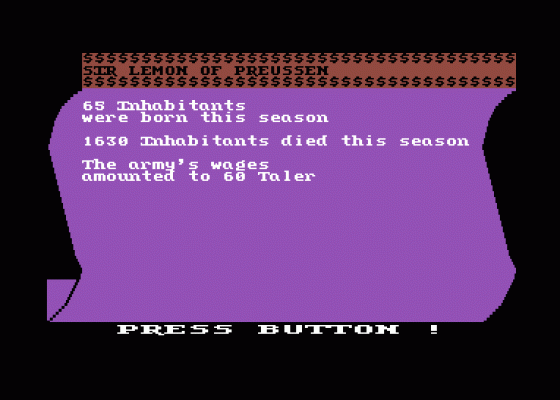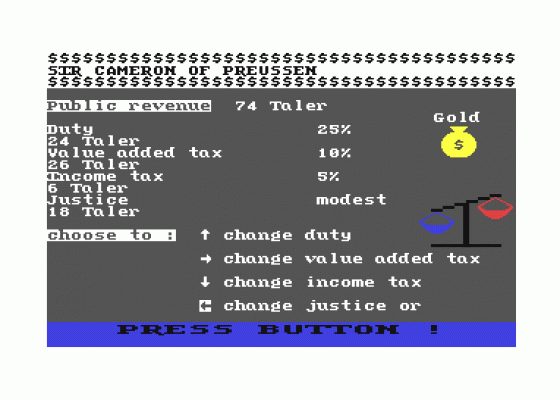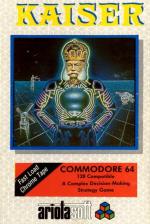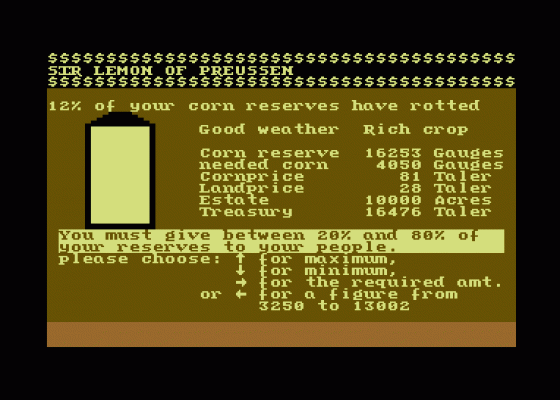
Zzap
 1st March 1986
1st March 1986
Categories: Review: Software
Publisher: Ariolasoft
Machine: Commodore 64/128
Published in Zzap #11
Kaiser
Kaiser involves from one to nine players competing against fate or each other to become Emperor of 18th century Germany. Each player begins life as a Regent, equipped with assets and an estate which must grow and prosper in order to bring success. The ultimate goal is to build five towns (consisting of five markets and three grain mills), possess at least 25000 hectares of land and have cash assets of 100000 Talers. Lastly, a palace and cathedral must be built. Not only names but gender are required, as this becomes relevant to the player's title. The game takes place in a series of phases which combine to make a yearly turn. During the turn, all options and responses are made via the joystick.
During the first phase, a harvest report arrives and must be dealt with. If the crop has been poor, then extra supplies of grain need to be purchased unless you want the population to die. If the harvest has been a bumper one, surplus grain may be sold off at a profit. The option to buy or sell land is also there for consideration. Selling land can bring extra income (if sale prices are judged well). Buying land is also necessary in order to build a palace and cathedral - both of which are required as status symbols during the game.
The next stage of the game is simply a status screen allowing you to study data on birth rate, death rate, revenue from markets and grain mills, army costs and how many people emigrated over the past year. It is purely informative and the game itself continues on the next screen.

This is where you set the tax and duty rates. Displayed are all the current levels of duty and income from each area (such as VAT) over the previous year. These may be changed by use of the joystick as on all the other screens. Also, the level of justice can be altered to increase income but this can have adverse effects, such as emigrations by 'victims of the state'.
Play then proceeds to another information display. A map of your estate is drawn each year, showing how many markets exist, how many mills are producing corn, how far building of the palace and cathedral have progressed, and size of the army. The map may be scrolled, rather crudely, across the screen. The diagrammatic information displayed on the map is clear and useful but rather unambitious on the visual side. Again, after study, the next stage of the game may be accessed.
With this year's revenue displayed at the top of the screen, there is now the option to decide how to spend it. New mills and markets are the cheapest form of expenditure, as they bring in an income from the next turn onwards. On the other hand, a start could he made building the palace (the instructions suggest the palace is built before the cathedral). Alternatively, money could be spent on the military. If a solo game is being played, this area is apparently inaccessible, so you can't fight a war with the computer. However, if a game does have more than one player, then armies can be bought (with the option of readily trained, but expensive, mercenaries available), sent out on manoeuvres and of course, sent to war with another nation. No matter how many players are involved, an army always has to be maintained at some level and consequently, is always a financial burden.

Once an army goes to war, a whole new game appears. Again it is totally joystick oriented and, through a series of prompts, forces may be deployed or put into action - whatever you require. Throughout a battle and at the end of the war, details of losses are made available. Fighting wars is definitely a costly business in terms of manpower, but it will drastically increase the amount of land owned, if successful.
After military matters have been resolved, the game returns to the first phase, one year on. However, if the turn has been a particularly good one, a new rank in the aristocracy will he given to you with the trapping of extra land that comes with it. On a more sombre note, the computer may decide you have gracefully passed away due to old age. This is the singular major random factor in the game. Automatically set at the start of the game, it is the same for all players, but there is no way of knowing when it will occur. The only thing that can aid you to a long life is the speed at which each turn is dealt with. The game contains a monitoring system which calculates how quickly different matters are dealt with and then determines your health.
The game is more like a computer version of diplomacy in miniature than a simulation, but there is a great deal of strategy involved. It could prove to be frustrating, however. More than once I thought my progress was good - only to be stopped in my tracks by the grim reaper himself. But maybe I was just unlucky. The war game is rather simple in terms of complexity but adds satisfying depth to an already subtlety demanding game. One good feature is the ability to access a status screen to examine how good your performance is. My only real gripe lies in the inability to fight wars against the computer. Definitely the kind of game that gets better with more players.
Verdict

Presentation 68%
Neatly packaged with well defined options.
Graphics 45%
Simple but effective.
Instructions 60%
A pity more atmosphere wasn't generated here. It might have made playing the game more interesting.

Authenticity 40%
The game isn't really a simulation but the effects of a bad harvest are fairly well handled.
Playability 66%
Once you get into the motions it's quite addictive. More playable with more people.
Value For Money 72%
Attractively priced compared to other offerings.
Overall 61%
Not bad at all. But unless there are other people around willing to play, you're going to find interest slacking - eventually.




